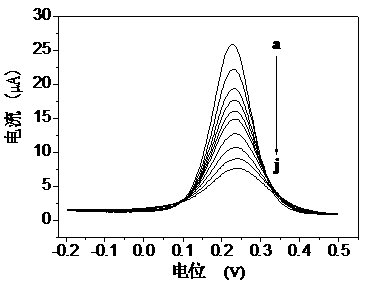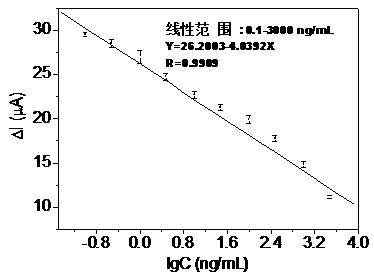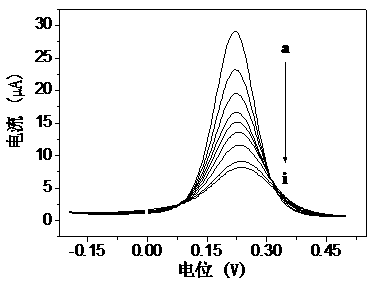An ultrasensitive electrochemical immunosensor for multi-residue detection of sulfonamides
A sulfonamide drug and immunosensor technology, which is applied in the fields of food safety testing and analytical chemistry, can solve the problems of complex operation, high testing cost, and difficulty in equipping basic testing departments and units, and achieves simple pretreatment, simple testing operation, and practicality. strong value effect
- Summary
- Abstract
- Description
- Claims
- Application Information
AI Technical Summary
Problems solved by technology
Method used
Image
Examples
Embodiment 1
[0026] Example 1 Preparation of electrochemical immunosensor
[0027] Place the cleaned glassy carbon electrode in a phosphate buffer solution (PBS, 0.067mol / L, pH=8.0) containing 2 μmol / L sulfadiazine, and scan for 10 weeks (scanning speed is 100 mV / S, potential range is -1.0~2.0 V), then place the scanning electrode in a PBS (0.067mol / L, pH=8.0) solution containing 100 μmol / L sulfadiazine and 0.1mol / L NaCl until it is stable (scanning speed is 100 mV / S , The potential range is -1.0~1.0 V), after rinsing and drying, the polysulfadiazine modified PSD-GCE electrochemical immunosensor can be obtained.
Embodiment 2
[0028] Example 2 Detection of Sulfadiazine (SD)
[0029] The PSD-GCE electrochemical immunosensor was prepared in exactly the same way as in Example 1, and it was immersed in a total volume of 50 µL containing 10 μg / mL sulfadiazine antibody and a series of different concentrations of sulfadiazine standard solution, 37 Incubate for 30 minutes at ℃, rinse with phosphate buffer solution and place it in K containing 2 mmol / L 3 [Fe(CN) 6 ] Differential pulse voltammetry (DPV) scan in KCl solution (0.1 mol / L), the DPV curve is as follows figure 1 As shown, the concentration of the curve from top to bottom in the figure is 3000 ng / mL, 1000 ng / mL, 300 ng / mL, 100 ng / mL, 30 ng / mL, 10 ng / mL, 3 ng / mL, 1 ng / mL, 0.3 ng / mL, and 0.1 ng / mL. Record the response current value of the sensor directly in the KCl solution without incubation as I 0 , The response current value measured after incubation with a standard solution containing a certain concentration of sulfadiazine is recorded as I x , The ...
Embodiment 3
[0030] Example 3 Detection of Sulfamethazine (SM2)
[0031] The PSD-GCE electrochemical immunosensor was prepared in exactly the same way as in Example 1, and it was immersed in a total volume of 50 µL containing 10 μg / mL sulfadiazine antibody and a series of different concentrations of sulfadimethazine standard solution Incubate at 37°C for 30 minutes, rinse with phosphate buffer solution, and place it in 2 mmol / L K 3 [Fe(CN) 6 ] Differential pulse voltammetry (DPV) scan in KCl solution (0.1 mol / L), the DPV curve is as follows image 3 As shown, the concentration of the curve from top to bottom in the figure is 400 ng / mL, 100 ng / mL, 25 ng / mL, 15 ng / mL, 5 ng / mL, 2.5 ng / mL, 1 ng / mL, 0.5 ng / mL and 0.2ng / mL. Record the response current value of the sensor directly in the KCl solution without incubation as I 0 , The response current value measured after incubating with a standard solution containing a certain concentration of sulfamethazine is recorded as I x , The response current ...
PUM
 Login to View More
Login to View More Abstract
Description
Claims
Application Information
 Login to View More
Login to View More - R&D
- Intellectual Property
- Life Sciences
- Materials
- Tech Scout
- Unparalleled Data Quality
- Higher Quality Content
- 60% Fewer Hallucinations
Browse by: Latest US Patents, China's latest patents, Technical Efficacy Thesaurus, Application Domain, Technology Topic, Popular Technical Reports.
© 2025 PatSnap. All rights reserved.Legal|Privacy policy|Modern Slavery Act Transparency Statement|Sitemap|About US| Contact US: help@patsnap.com



